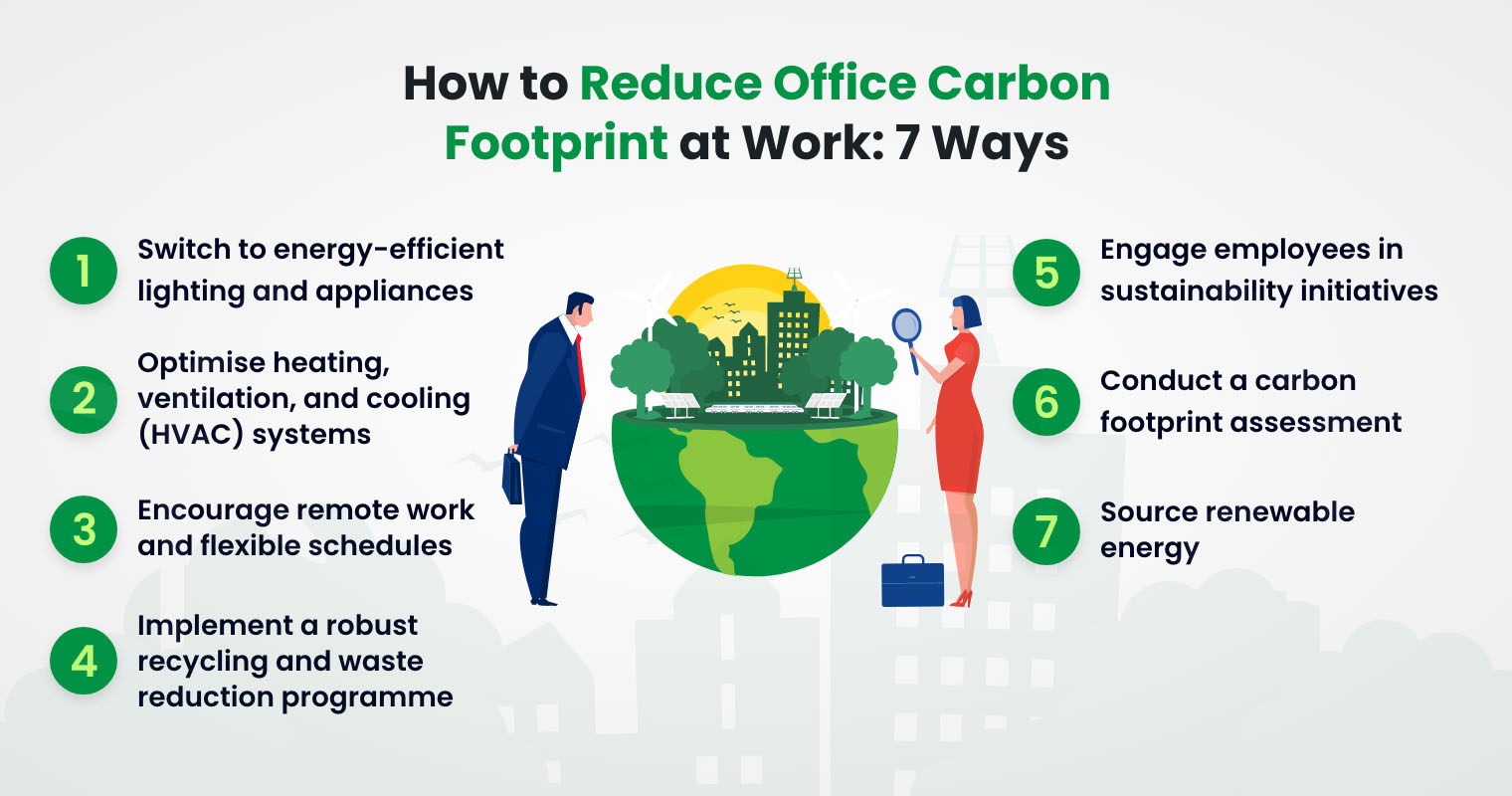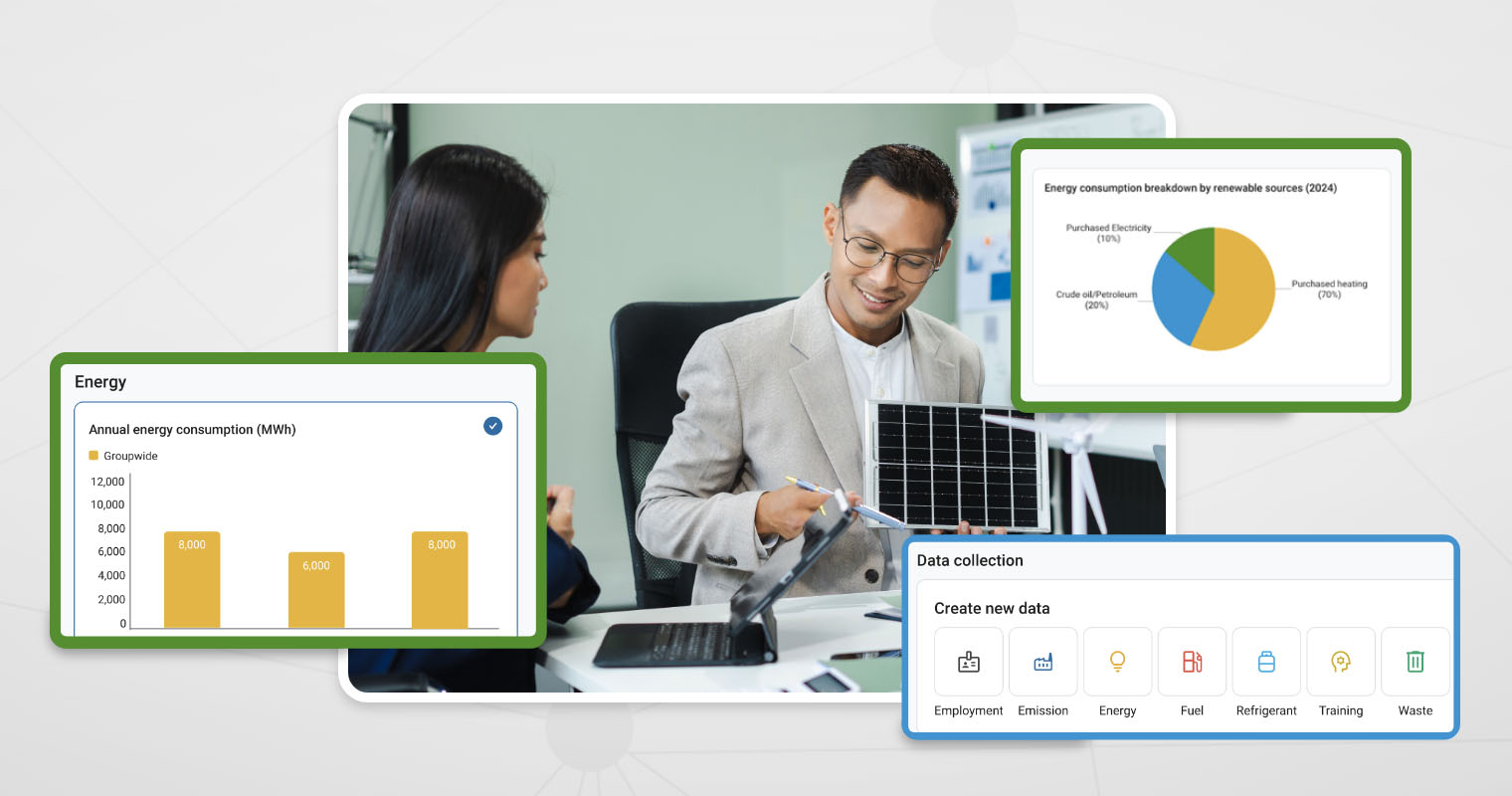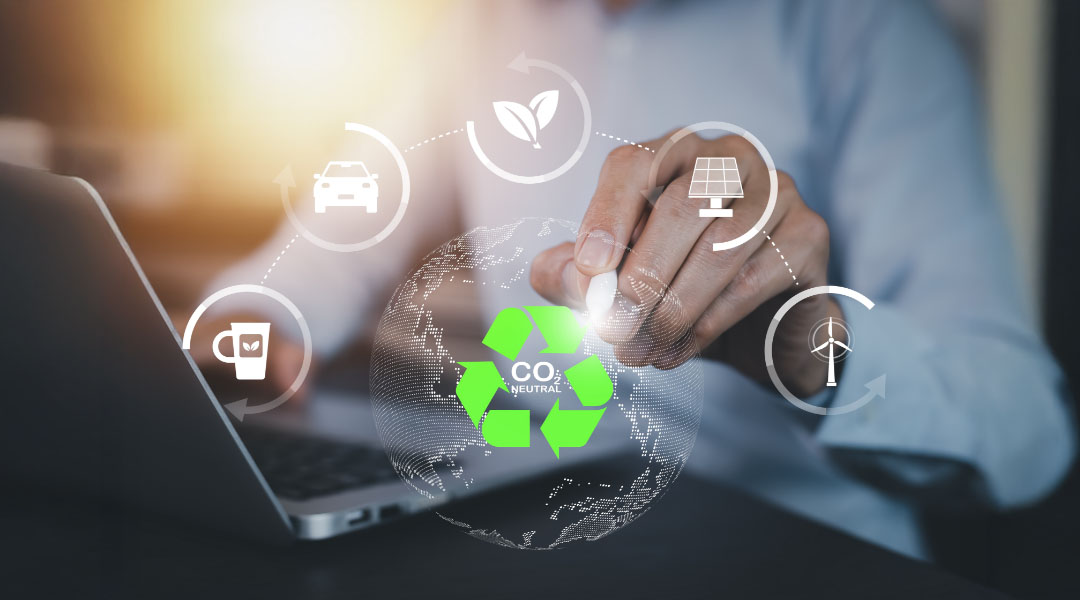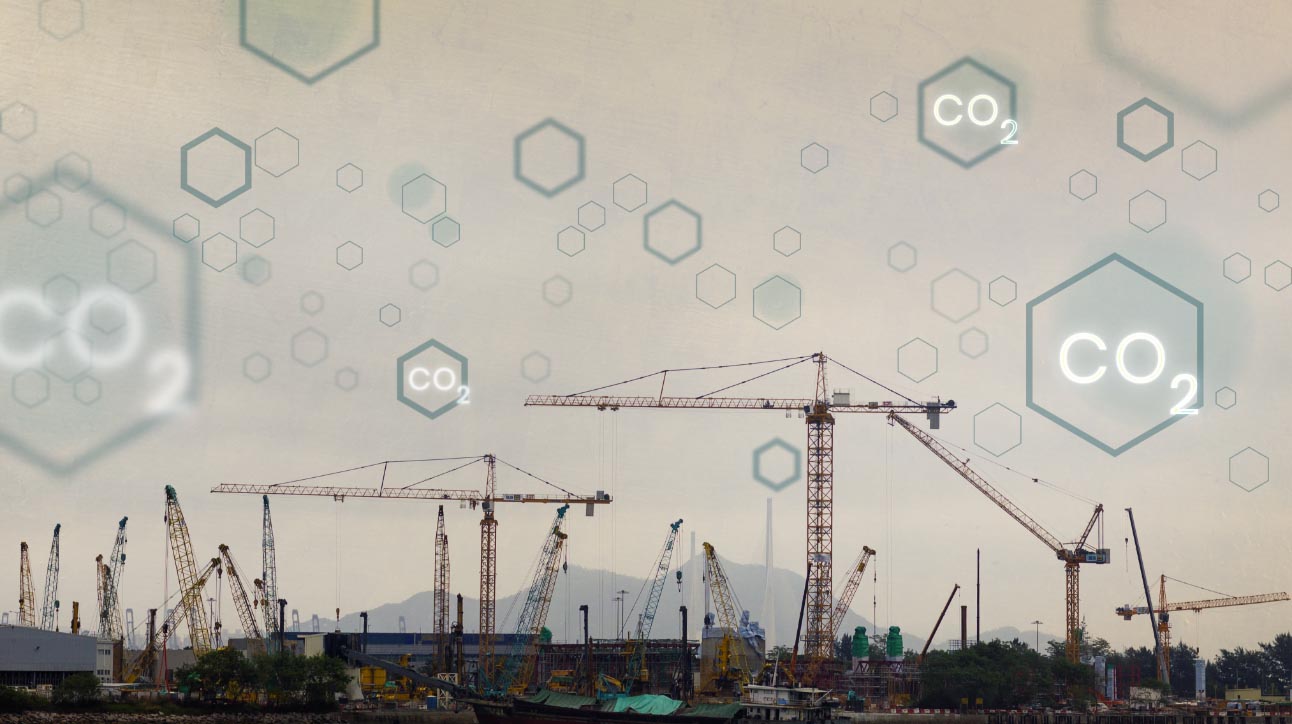Reducing carbon emissions in the workplace is an essential step for businesses looking to contribute to a more sustainable future. After all, offices consume significant energy — these spaces produce waste and contribute to greenhouse gas emissions in ways that often go unnoticed.
Beyond environmental responsibility, organisations face increasing pressure to reduce their carbon footprint due to rising stakeholder expectations, evolving ESG compliance regulations, and the growing urgency of climate change. Investors, customers, and regulators demand stronger sustainability commitments, making it essential for corporate spaces to act.
Understanding how they impact the environment and adopting sustainable practices is the first step for businesses to lower their carbon footprint. This article explores key strategies to help your organisation go greener and commit to action without putting efficiency on the line.
What is carbon footprint in the office?
An office’s carbon footprint refers to the total greenhouse gas emissions generated by its daily activities. This includes energy consumption, heating and cooling, electronic device usage, employee commuting, waste generation, and supply chain operations.
With climate change becoming a growing concern, businesses are now expected to take responsibility for their carbon footprint. Undoubtedly, the industrial and commercial sectors are among the largest contributors to the effects of the crisis.
According to the International Energy Agency (IEA), commercial buildings account for over 30% of global energy consumption and nearly 40% of total CO₂ emissions from energy use. Office operations, from electricity usage to employee commuting, add up to a substantial carbon footprint.
Here’s how different office activities contribute to carbon emissions:
- Energy consumption: Offices require lighting, heating, cooling, and electronic devices that run continuously. Overall, commercial building accounts for 36% of global energy demand.
- Transportation: Employee commuting and business travel contribute to fuel consumption and emissions. The EPA reports that in the United States alone, transportation accounts for nearly 29% of national greenhouse gas emissions, making it one of the largest sources.
- Waste production: Offices generate large amounts of waste, from excessive paper used to single-use plastics. Unfortunately, not everything that is disposed of should be considered waste. In the largest study of global commercial building waste published by The Journal of Solid Waste Technology and Management in 2022, researchers found that 62% of waste from commercial buildings could be kept out of landfills through recycling or composting. A third of the “waste” is organic materials alone.
- Water usage: Offices consume significant amounts of water that require energy for treatment and distribution. In the U.S., commercial buildings consume 13 gallons per square foot annually.
Why should you reduce company carbon footprint?
Reducing an office’s carbon footprint can be both an environmental responsibility and a strategic business decision, in terms of:
Cost savings
Sustainability efforts can lower operational expenses by improving energy efficiency and reducing waste. Businesses that switch to renewable energy or optimise their heating, ventilation, and air conditioning (HVAC) systems often experience reduced utility bills over time.
Regulatory compliance
Governments and industry bodies are tightening environmental regulations. In the last few years, most of these organisations have required businesses to monitor and report their carbon emissions.
For example, the European Union’s Corporate Sustainability Reporting Directive (CSRD) mandates that companies disclose their environmental impact, while the U.S. Securities and Exchange Commission (SEC) has proposed climate disclosure rules for publicly traded companies. Proactively implementing sustainable practices helps businesses stay ahead. Through these initiatives, they avoid penalties, ensure compliance with the latest requirements, and position themselves as leaders in corporate responsibility.
Enhanced brand reputation
Consumers, investors, and stakeholders are increasingly drawn to businesses that align with environmental and social values. A strong commitment to sustainability includes: setting measurable carbon reduction targets, adopting renewable energy, reducing waste, and publishing sustainability reports aligned with global frameworks like the Global Reporting Initiative (GRI) or Task Force on Climate-related Financial Disclosures (TCFD).
Companies that actively make space for green initiatives such as carbon offset programmes, sustainable sourcing, and transparent ESG reporting can improve public perception. Thus, strengthening customer loyalty and attracting ethical investors.
Employee engagement and retention
A growing number of employees prefer to work for companies that prioritise environmental and social responsibility. Green initiatives, such as eco-friendly office policies and sustainability-driven corporate culture, can boost employee morale, increase retention, and attract top talent.
How to Reduce Office Carbon Footprint at Work: 7 Ways
There are several impactful ways businesses can reduce their carbon footprint. From energy efficiency improvements to waste reduction initiatives, below are seven strategies that companies can adopt to create a more sustainable workplace.

1. Switch to energy-efficient lighting and appliances
Traditional office lighting and appliances consume excessive amounts of electricity. This increases both carbon emissions and operational costs. Upgrading to energy-efficient alternatives can significantly reduce an office’s energy consumption while maintaining productivity.
Businesses can replace incandescent bulbs with LED lighting, which uses up to 80% less energy and lasts much longer. Installing motion-sensor lighting in low-traffic areas like conference rooms and restrooms further prevents unnecessary energy use. Additionally, opting for Energy Star-certified office equipment, such as computers, printers, and refrigerators, ensures lower electricity use without sacrificing performance.
Energy Star is a government-backed certification that identifies products meeting strict energy efficiency guidelines set by the U.S. Environmental Protection Agency (EPA), helping businesses reduce energy consumption and lower utility costs.
Rockefeller Center has recently taken steps to enhance its energy efficiency by replacing its historic neon signs with eco-friendly LED lighting. This transition, which began in December 2024, aims to preserve the building’s classic aesthetic while significantly reducing energy consumption. As an iconic landmark in New York City, this move reflects a broader commitment to sustainability and aligns with efforts to lower carbon emissions in commercial properties.
2. Optimise heating, ventilation, and cooling (HVAC) systems
Heating and cooling account for a significant portion of an office’s energy consumption. Inefficient HVAC systems not only waste energy but also lead to higher maintenance and operational costs.
To improve efficiency, businesses should schedule regular HVAC maintenance to ensure systems function optimally. Installing programmable or smart thermostats helps regulate indoor temperatures automatically, reducing energy waste. Enhancing office insulation, such as sealing windows and doors, further minimises heat loss in winter and keeps interiors cooler in summer, reducing reliance on heating and air conditioning.
Salesforce has taken significant steps to optimise its office spaces through its Salesforce Climate Action Plan, aiming for deep decarbonisation by reducing emissions associated with the construction, operation, and maintenance of its buildings, materials, and supporting services.
3. Encourage remote work and flexible schedules
Employee commuting is also a major contributor to carbon emissions, particularly in urban areas.
Implementing remote or hybrid work models reduces transportation-related emissions while also decreasing overall office energy use.
Businesses can establish flexible work policies that allow employees to work remotely several days a week. Virtual meeting tools, such as Zoom and Microsoft Teams, can replace unnecessary business travel. Additionally, downsizing office spaces in response to lower on-site employee numbers can lead to further energy savings.
Spotify has successfully embraced a remote-first approach, allowing employees to work from anywhere. This strategy has not only reduced the company’s office energy consumption but also significantly cut down on emissions related to employee commuting.
4. Implement a robust recycling and waste reduction programme
Office waste, including paper, plastic, and electronic waste, contributes significantly to environmental pollution. A structured recycling and waste reduction programme ensures that materials are properly sorted and reused, minimising landfill contributions.
Businesses can set up clearly labelled recycling bins for paper, plastic, and electronic waste in common areas. Encouraging employees to use reusable containers, water bottles, and utensils further reduces single-use plastics. Partnering with local recycling organisations enhances waste management efforts, ensuring materials are processed responsibly.
Unilever has successfully implemented zero-waste-to-landfill policies across many of its office locations. Through dedicated recycling programmes and waste reduction strategies, the company ensures that all waste is either reused, recycled, or composted, significantly minimising its environmental impact.
5. Source renewable energy
Relying on fossil fuel-based electricity contributes significantly to an office’s carbon footprint. Transitioning to renewable energy sources such as solar, wind, or hydropower can drastically cut emissions and reduce long-term energy costs.
Businesses can install solar panels on office buildings to generate clean energy onsite. For companies that cannot install renewable energy systems, purchasing green power from certified providers is a viable alternative. Additionally, signing corporate power purchase agreements (PPAs) allows businesses to directly support renewable energy projects.
Apple has set a global benchmark by running all of its offices on 100% renewable energy. Through investments in solar and wind power projects, the company has significantly reduced its carbon footprint while demonstrating corporate leadership in sustainability. More recently, the company announced that over 18 gigawatts of clean electricity now power its global operations and supply chain. This is more than triple the amount in 2020. The company is also investing in solar power in the U.S. and Europe to help offset the energy used by customers to charge their devices.
6. Conduct a carbon footprint assessment
Understanding where emissions come from is the first step in reducing them effectively. A carbon footprint assessment helps businesses track their environmental impact and identify areas for improvement. Measuring emissions from energy use, supply chains, and employee activities allows companies to set clear carbon footprint reduction targets and implement meaningful changes.
Mars Inc. has successfully leveraged this approach, reducing its carbon footprint by 8% in 2023 compared to a 2015 baseline, despite a 60% business growth. The company ties sustainability goals to executive pay and works closely with suppliers to ensure alignment with its net-zero targets.
7. Engage employees in sustainability initiatives
Encouraging employees to adopt sustainable practices helps embed environmental responsibility into a company’s culture. Businesses can introduce incentives, education programmes, and workplace policies that make it easier for staff to contribute to carbon reduction efforts.
Some companies, like Vendredi and Ubiq, have implemented innovative policies that grant employees extra vacation days if they opt for low-carbon travel methods, such as trains or buses for long journeys. At Vendredi, one in three employees has taken advantage of this programme, significantly reducing travel-related emissions.
Achieving Carbon Neutrality for Businesses

Carbon neutrality refers to balancing the amount of carbon dioxide emitted with an equivalent amount removed from the atmosphere. This means reducing emissions as much as possible and offsetting the remainder through initiatives like carbon capture, reforestation, and renewable energy investments.
Achieving carbon neutrality helps businesses mitigate their environmental impact, comply with sustainability regulations, and enhance their reputation among environmentally conscious consumers and investors.
Many global companies have already committed to carbon neutrality as part of their long-term sustainability strategies.
For example, Microsoft has pledged to become carbon negative by 2030, meaning it will remove more carbon from the atmosphere than it emits. DuPont has committed to achieving net-zero carbon emissions by 2050, setting science-based targets aligned with the Paris Agreement to limit global temperature rise. Meyers, on the other hand, has pledged to reach carbon neutrality within its operations by 2024 by transitioning to 100% carbon-free electricity and offsetting remaining emissions through verified measures.
To work towards carbon neutrality, businesses can take the following steps:
Invest in carbon offset programmes
Carbon offsetting involves funding projects that reduce or remove greenhouse gas emissions to compensate for a company’s own emissions. Businesses can invest in initiatives such as reforestation, renewable energy development, and carbon capture technologies.
Supporting verified carbon offset programmes, such as those certified by the Gold Standard or Verified Carbon Standard (VCS), ensures that projects effectively contribute to emissions reduction.
Companies like Delta Air Lines offset millions of metric tonnes of carbon emissions by investing in forestry and renewable energy projects to balance the environmental impact of their flights.
Implement circular economy principles
Instead of following the traditional ‘take-make-dispose’ model, a circular economy aims to minimise waste by reusing, recycling, and repurposing materials.
For example, IKEA has committed to becoming a circular business by 2030, designing all products using renewable or recycled materials and offering furniture buy-back programmes to extend product lifecycles. Implementing closed-loop manufacturing systems also helps companies significantly cut down on resource waste and emissions.
Integrate sustainability into business strategy
Carbon neutrality should be a core business objective rather than a one-time initiative. Companies can embed sustainability into their operations by setting clear emissions reduction targets, adopting science-based goals, and aligning with frameworks such as the Science Based Targets initiative (SBTi).
Regular sustainability reporting through standards like GRI and TCFD helps track progress and ensure transparency. Unilever, for instance, has embedded sustainability into its corporate strategy, committing to net-zero emissions across its entire value chain by 2039.
Achieving carbon neutrality requires a combination of emissions reduction, responsible resource use, and strategic investment in environmental initiatives. While the transition may require upfront investments, businesses that commit to carbon neutrality benefit from long-term cost savings, regulatory compliance, and improved stakeholder trust.
Turn Carbon Footprint Reduction Goals into Real Progress with Convene ESG

Reducing the carbon footprint of an office requires a combination of energy efficiency, waste reduction, and employee engagement. Adopting sustainable practices and leveraging ESG reporting software allows businesses to take meaningful steps toward a greener future while benefiting from cost savings and regulatory compliance.
With Convene ESG, organisations can simplify their ESG reporting journey through automated data collection, a centralised digital repository, and best practice recommendations for full compliance with evolving sustainability regulations. The platform’s dashboards provide real-time oversight of ESG performance, allowing businesses to track goals, benchmark progress, and align their strategies with stakeholder expectations.
For companies looking to take their commitment even further, Convene ESG also features a powerful carbon calculator that measures scope 1, 2, and 3 emissions using local emission factors in line with international standards. By reinforcing data governance and ensuring transparent, future-proof reporting, these solutions empower organisations to take meaningful steps toward sustainability while maintaining efficiency and regulatory compliance.
Book a demo today to see how Convene ESG can help you achieve your sustainability goals.
Beatrice Asuncion has spent the past decade in the digital marketing world, helping brands sound like real people. As a seasoned copywriter and content writer, she’s guided everyone from local pastry shops to international tech companies in finding their voice—and occasionally, their sense of humor. Lately, her work with Convene ESG reflects her commitment to helping organizations communicate their environmental, social, and governance (ESG) initiatives, showing how these values can be embedded authentically across all messaging.















